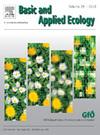Management-induced micro-habitats in crop fields alter the trait composition of arable plant communities
IF 3.5
2区 环境科学与生态学
Q2 ECOLOGY
引用次数: 0
Abstract
Modern cropping systems typically involve extensive soil disturbance and high fertiliser use. Plants other than the crop are controlled to avoid potential crop yield losses. However, crop fields are not homogeneous ecosystems. Rather, they comprise several micro-habitats differing in disturbance intensity, inter-specific competition and resource availability. Understanding how weed and crop management affects the trait composition of arable plants could help finding management practices that favour less competitive species or species providing valuable ecosystem services. This study examined the traits within the arable plant community and their association with disturbance and competition levels. The relationship between micro-habitats and plant species traits was investigated using RLQ analysis, in which micro-habitats and traits were linked using species count data. The environmental variables forming micro-habitats were: biomass of main crop and intercropped service crop, frequency of mechanical disturbance and within-crop sampling location. Intermediate to high competition and intermediate disturbance reduced the presence of competitive arable plant species compared with low competition and highest and lowest disturbance, while favouring a diverse group of ruderal species. High service crop biomass in the main crop row, compared with low, reduced the presence of arable plant species that were associated both with ruderal and competitive traits (competitive-ruderals), while favouring the diverse group of ruderal species. The analysis showed distinctions in traits associated with different micro-habitats, but to better guide interpretations regarding species’ harmfulness to crops, species characteristics based on combinations of traits have to be defined at a finer scale, especially for ruderal species.

管理诱导的农田微生境改变了耕地植物群落的性状组成
现代种植系统通常涉及广泛的土壤扰动和大量的肥料使用。控制作物以外的植物以避免潜在的作物产量损失。然而,农田并不是同质的生态系统。相反,它们由几个在干扰强度、种间竞争和资源可用性方面不同的微生境组成。了解杂草和作物管理如何影响可耕种植物的性状组成,有助于找到有利于竞争力较弱的物种或提供有价值的生态系统服务的物种的管理方法。本研究探讨了耕地植物群落的性状及其与干扰和竞争水平的关系。采用RLQ分析方法对微生境与植物物种性状之间的关系进行了研究,其中利用物种计数数据将微生境与植物物种性状联系起来。形成微生境的环境变量为:主要作物和间作服务作物生物量、机械干扰频率和作物内采样位置。与低竞争、最高和最低干扰相比,中等到高度竞争和中等干扰减少了竞争性可耕地植物物种的存在,而有利于多样化的原始物种群体。与低生物量相比,主作物行的高服务作物生物量减少了与粗粮性状和竞争性性状(竞争性粗粮)相关的可耕种植物物种的存在,而有利于不同的粗粮物种群。分析显示了与不同微生境相关的性状的差异,但为了更好地指导对物种对作物的危害的解释,基于性状组合的物种特征必须在更精细的尺度上定义,特别是对于原始物种。
本文章由计算机程序翻译,如有差异,请以英文原文为准。
求助全文
约1分钟内获得全文
求助全文
来源期刊

Basic and Applied Ecology
环境科学-生态学
CiteScore
6.90
自引率
5.30%
发文量
103
审稿时长
10.6 weeks
期刊介绍:
Basic and Applied Ecology provides a forum in which significant advances and ideas can be rapidly communicated to a wide audience. Basic and Applied Ecology publishes original contributions, perspectives and reviews from all areas of basic and applied ecology. Ecologists from all countries are invited to publish ecological research of international interest in its pages. There is no bias with regard to taxon or geographical area.
 求助内容:
求助内容: 应助结果提醒方式:
应助结果提醒方式:


